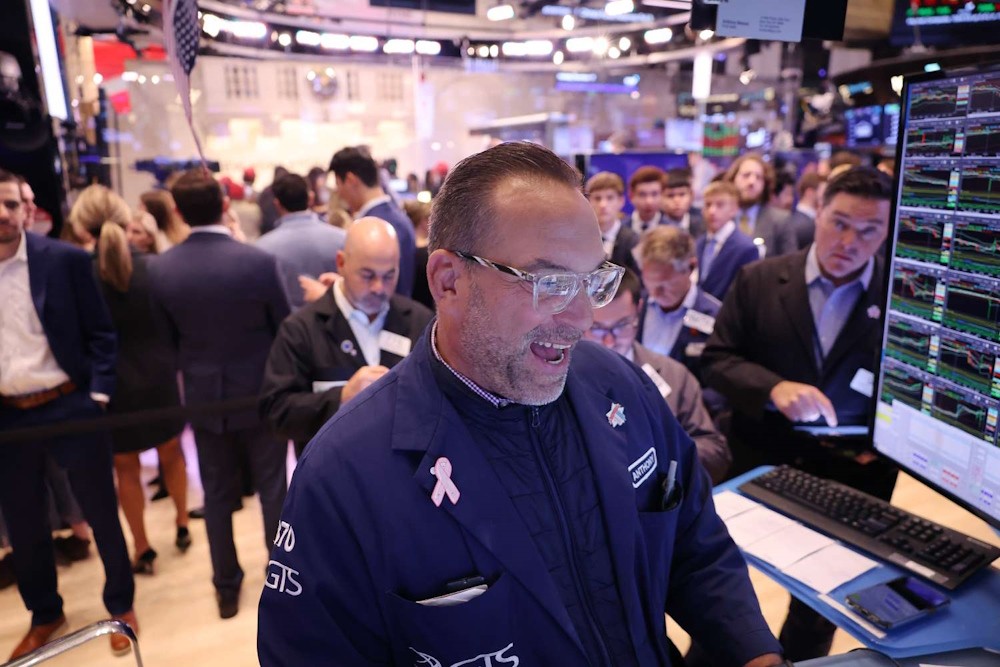
Dow Futures increased on Friday, indicating a continuation of the gains observed in the previous session, which were driven by investor optimism regarding positive second-quarter earnings and indications of robust growth conditions, notwithstanding ongoing tariff uncertainties Netflix’s earnings top estimates, yet shares in the streaming giant decline as analysts indicate that its results may not have met elevated expectations. In other developments, a significant consumer sentiment report is anticipated, as Bitcoin experiences an uptick following the passage of three bills by U.S. House lawmakers, which seek to create a definitive legal framework for digital assets.
Dow futures contract experienced an increase of 64 points, representing a 0.1% rise, while S&P 500 futures advanced by 8 points, also a 0.1% gain, and Nasdaq 100 futures saw an uptick of 27 points, equating to a 0.1% increase. The principal indices on Wall Street experienced an uptick on Thursday, driven by investor sentiment influenced by a succession of positive corporate earnings reports, alongside executive remarks that analysts characterized as optimistic. This week’s economic data suggests that the U.S. economy is gaining momentum, despite the increasing inflationary pressures stemming from President Donald Trump’s assertive trade policies. Experts have cautioned that taxes may lead to increased prices and hinder economic performance, although uncertainties persist regarding the possible magnitude of the tariffs’ effects.
Netflix’s shares experienced a slight decline in after-hours trading following the release of its second-quarter earnings and outlook, which, while solid, did not meet the elevated expectations set by analysts. Driven significantly by the triumph of the concluding season of its blockbuster series “Squid Game,” Netflix reported a quarterly diluted per-share profit of $7.19, surpassing estimates of $7.08, as per LSEG data referenced by Reuters. Netflix has been actively seeking to integrate new offerings such as live events to enhance viewership and attract advertisers. Additionally, the company has raised its annual revenue guidance to a range of $44.8 billion to $45.2 billion, an increase from the previous estimate of $44.5 billion. The company indicated that the enhanced forecast was, in part, supported by a recent depreciation of the U.S. dollar, which analysts at Vital Knowledge characterized as a “low-quality source.” Analyst Thomas Monteiro remarked that the outlook “now feels quite conservative,” noting that this is “problematic for a stock priced for perfection.” Netflix’s stock price has surged by more than 43% so far this year, underpinned by expectations that the firm will continue to bolster its status as one of the most formidable entities in the streaming sector.
On the economic calendar, investors are expected to monitor the upcoming release of a monthly gauge of consumer sentiment. The index from the University of Michigan appears to have slightly increased in July, with inflation expectations remaining relatively stable. “We will observe if 1-year inflation expectations have persisted in their decline: they presently stand at 5%, although there is a significant divergence in views between Democrat (very high) and Republican (very low) respondents,” analysts at ING remarked in a note. Friday’s release will follow distinct reports from this week that depict an American economy appearing to be on stable ground, at least for the time being. On Thursday, retail sales figures exceeded expectations, while weekly jobless claims were reported below forecasts. Inflation remained largely consistent with projections in June, although tariffs appear to be exerting upward pressure on the prices of certain goods.
Considering the current economic landscape, the Federal Reserve has predominantly embraced a “wait-and-see” approach regarding forthcoming interest rate decisions. Fed Governor Christopher Waller indicated on Thursday that a rate cut at the central bank’s upcoming meeting this month is warranted, pointing to increasing risks to the economy.He noted that the increase in inflation due to tariffs is expected to be a transient phenomenon rather than a lasting characteristic of the economy. “It makes sense to cut” the Federal Open Market Committee’s policy rate by a quarter of a percentage point at the Fed’s July 29-30 gathering, Waller stated during an event. The remarks arise as Fed Chair Jerome Powell encounters mounting pressure from Trump to promptly reduce borrowing costs in order to support economic growth. Powell, emphasizing the Federal Reserve’s autonomy from the executive branch, has advocated for a more measured strategy that enables policymakers to evaluate the broader implications of Trump’s tariffs.
Bitcoin experienced a temporary increase, surpassing $120,000 during Asian trading hours on Friday, positioning itself for a fourth consecutive weekly gain, following the U.S. House of Representatives’ approval of three bills designed to establish a new regulatory framework for cryptocurrencies. The world’s largest cryptocurrency last traded 1.1% higher at $119,583.3,the token experienced a significant increase, reaching unprecedented levels exceeding $123,000 at the beginning of the week. However, profit-taking at record levels and apprehensions regarding the final approval of cryptocurrency legislation moderated the increases. One of the bills, referred to as the “GENIUS Act,” passed through the House with a bipartisan vote of 308-122. It mandates that stablecoin issuers maintain high-quality, dollar-equivalent reserves and submit to regular audits, while instituting oversight at both federal and state levels. The House also approved two additional bills. The CLARITY Act seeks to clarify the regulatory framework surrounding digital tokens, determining their classification under the Securities and Exchange Commission (SEC) or the Commodity Futures Trading Commission (CFTC). In the interim, the Anti-CBDC Surveillance State Act restricts the Federal Reserve from launching a central bank digital currency unless it receives clear authorization from Congress.
